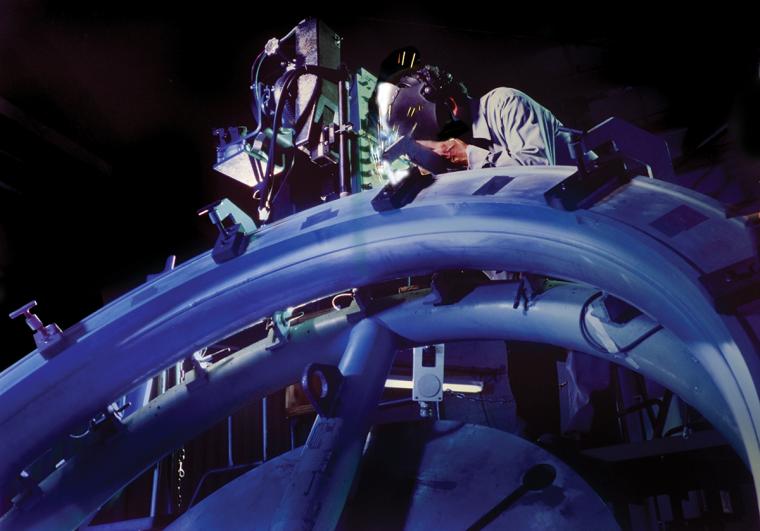

A Pause, and a Predicted Recovery
The global pandemic, however, has devastated the commercial aerospace manufacturing industry. As revenue passenger kilometers plummeted by two-thirds in 2020, the commercial aviation industry experienced a similar drop in output. However, with COVID-19 waning in many parts of the world, air travel is making a comeback and many industry observers predict a full recovery by the end of 2023. Air travel is predicted to resume a growth rate well above Global GDP. Furthermore, with predictions that the global middle class will increase in the next decade from about one quarter of the population to around 60 percent, there is the likelihood of nearly three billion potential new customers who will be able to afford air travel.
At the same time, the world is racing to net-zero carbon emissions targets. While aviation contributes less than two percent of global carbon emissions, all industries must contribute to these targets, requiring significant innovation in A&D. The aviation product life cycle is currently measured in decades. To meet the demands of the future, the aerospace industry will need to quicken the pace of product development.
While commercial air travel took a dive during the global pandemic, the defense industry continued to perform steadily. The U.S. is the world’s largest defense exporter, and this industry continues to grow. In addition to the Middle East, there is increased export activity in Asia in response to the military modernization of China, as well as the North Korean threat. The U.S. is also seeing a resurgence in demand from European countries, partly in response to a more aggressive Russia.
Another emerging trend is the boom in commercial space. The rate of rocket launches is growing exponentially to support the massive expansion of commercial satellite networks, as well as renewed focus on space exploration and the burgeoning space tourism industry.
What Does It Mean for Manufacturers?
With such growth, what should manufacturers consider for research and development (R&D) and manufacturing site development and expansion? PricewaterhouseCoopers (PwC) annual global and state-by-state review of aerospace manufacturing attractiveness, an aerospace industry review it began performing in 2013, provides initial analysis and extensive interviews with industry executives. Over the years, the methodology has been refined to include the following categories:
• Cost – Six metrics that include labor cost, labor productivity, energy, and transportation costs.
• Labor – Five metrics, including the size of the A&D workforce, education categories and union flexibility.
• Infrastructure – Includes five metrics related to energy, roads, airports, railroads, and Internet.
• Industry – Includes six metrics related to the size, growth, and maturity of the industry.
• Economy – Includes six metrics related to size, growth, inflation, and subsidies.
• Tax policy – Includes six metrics related to corporate and individual income tax, sales, and property taxes.
• Geopolitical risk – For the country analysis, PwC uses metrics related to political stability, corruption, and natural disasters.
In its rankings, PwC weighs each of these categories equally. However, it emphasizes that each user of its analysis may weigh these categories differently, thus the analysis can be tailored. The 2021 report will be published later this year. The 2020 results follow.
Country Analysis
Within the top 10 countries, there are a few surprises since many people think only in terms of industry size. The U.S., UK, France, Germany, Canada and Singapore are known for their aerospace prowess. When all factors in the analysis are considered, however, several surprises emerge. Australia, Japan, South Korea, Switzerland, and Hong Kong are competitive across the board and have emerging aerospace capabilities. Also noteworthy, while China did not make the top 10 overall list, it holds seventh industry rank, as the country has invested significantly in developing a domestic aerospace industry including foreign investment in assembly lines.
United States
The U.S. consistently places first in the aerospace manufacturing rankings, partly because of the aerospace industry’s significant scale, supported by a relatively strong economy and active defense posture. Within the Industry category, the U.S. was first in industry size and maturity, as it continues to have the highest combined proportion of global aircraft deliveries and defense spending. Accordingly, the U.S. performance in Industry far exceeded that of other countries in the analysis. The U.S. also placed high in the Labor, Geopolitical Risk, and Infrastructure categories.
However, the United States’ strong performance across all metrics does not reflect some of the underlying risks to maintaining industry leadership:
Tax policy. The U.S. ranked 25th in tax policy, which is a significant improvement from 38th in 2017, due to tax reform in 2018. However, tax policy is still the nation’s least competitive category. While tax reforms have made the U.S. more competitive, there are current proposals to increase taxes. Further, the extent of the advantage could be temporary, as many countries are considering a competitive response.
Labor. While the U.S. ranked third in labor, the ranking is based largely on the size of the A&D workforce and strong productivity. The U.S. still has a significant skills gap, as well as a demographic gap. As all industries race toward “digital transformation,” there is a digital divide, as well as fierce competition for skilled tech talent. These factors have prompted an industry-wide need to invest in digital training and education. Furthermore, policymakers at the federal and state level should consider support for digital skills and incentives to protect or enhance the competitiveness of the nation’s top exporter.
The demographic gap impacting the U.S. A&D industry is often referred to as the “lost generation.” A significant number of Baby Boomers are retiring in the coming years without an adequate bench of younger workers to replace them. The concern is particularly acute among engineers and skilled manufacturing talent at defense companies, which reduced their workforces and cut back on hiring in the years between the end of the Cold War in 1991 and the start of the war on terror in 2001.
Many executives struggle with recruiting workers with the appropriate skills such as engineering and skilled manufacturing. Engineering skills have been evolving away from mechanical engineering to electrical engineering and software engineering, and now to computer and data science as well as analytics to drive technologies like automation, artificial intelligence and autonomy. As a result, many of today’s newer aircraft are essentially flying computers.
Recent years have seen some success in public/private partnerships between industry and universities to address the skills gap. Yet as the digital age widens this gap, efforts in this area need to increase significantly. This requires greater participation by federal and state governments, which may need to include immigration reform designed to bolster critical skills.
Infrastructure. While the U.S. ranked eighth in infrastructure, many people believe the U.S. has significantly underinvested, resulting in much of the country’s infrastructure badly in need of repair or replacement. Currently there is bipartisan support for infrastructure investment, although many of the details remain contentious.
Infrastructure such as the next-generation air traffic control (ATC) system is designed to make aviation safer, more reliable, and more efficient. The system is particularly important to improve capacity in saturated markets and allow for continued growth. The next-gen ATC is the implementation of dozens of new technologies, including GPS tracking to replace the radar-based ground system. Additionally, many of the nation’s airports need modernization to accommodate current volumes and allow for growth, as well as improving the consumer experience.
Beyond aviation infrastructure, many of the nation’s roads, bridges, and railroads need modernization to allow the aerospace (as well as many other industries) supply chain to operate efficiently and support growth. Given the practical limitations associated with federal and state budgets, greater private funding and tolling could work in many instances to supplement any future infrastructure bill.
Cost. While the U.S. is competitive in cost, ranked fourth, energy will be a strategic differentiator in the future. As the world seeks “greener” energy sources to achieve net-zero carbon emissions, the countries that can develop and implement these new energy sources in a cost-effective manner will have a competitive advantage. Furthermore, while some companies have historically generated some of their own energy, new technologies mean companies are less reliant on the grid than ever before. In fact, many experts believe the future of energy is distributed power generation. Already, some companies are using a combination of technologies including solar and wind to supply their energy needs.
Innovation. The most important aspect of future competitiveness is, of course, innovation. Innovation is not measured in the PwC analysis partly because innovation metrics are hard to find, and innovation is seen as more specific to a company rather than a geography. Surely, though, governments have influence here. Many of the world’s leading industries were developed because of research for defense and space programs: computers, the Internet, GPS and many telecommunications applications, to name a few.
Tomorrow’s innovations will be digital, particularly around artificial intelligence. Some governments, such as China and Russia, are strategically investing in these areas of innovation. With big technology companies far outspending the government on R&D, federal funding is, perhaps, less critical than it was during the space race. However, strategic government spending in areas such as artificial intelligence is still critical to national security and competitiveness and should be prioritized.
There are several strategic decisions and investments companies can make to drive innovation, as well as critical policies and investments for federal and state governments and public institutions to ensure that the U.S. remains the leader in A&D as well as many other industries. These include:
• Investment in digital technologies, particularly artificial intelligence
• Investment in the workforce of the future, particularly digital skills
• Investment in the nation’s infrastructure, particularly next-generation air traffic control; and
• Investment in clean, affordable energy.
The companies and countries that can create competitive advantage in these areas will be tomorrow’s leaders. T&ID
